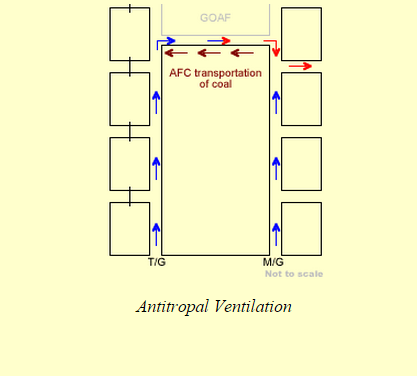SYSTEMS
Ventilation 0 CommentThe type of ventilation system used in a longwall mine is dependant upon the conditions found at each mine. The most influencial factor in the choice of ventilation system is the amount of gas that is present in the mine atmosphere. If the mine is considerably gassy the gas in the mine this has to be removed from the working panel as quickly and safely as possible.
The most common types of ventilation systems found in Australia are:
- “R” System
- The “R” (Reverse system as the intake air travels in the reverse direction to the return air) system is suitable for coal seams that have very low gas emission rates beacuse the goaf is not well ventilated and the goaf gasses are actually returned in the tailgate roadways. Also known as “U” as the air path is a similar shape to the letter “U”.
- “R” System for Gassy Goaves
- This system is suitable for coal seams with moderate gas emmission rates (5 – 10 m3/t). The bleed returns from the goaf are diluted with 20 -30 m3/s of intake air from the panel intakes, depending on gas emission rates. The longwall face is ventilated with 15 – 25 m3/s of air.
- “Z” system
- The “Z” system provides the greatest pressure differential accross the goaf and gives the most flexibility for the use of dilution intakes. It is used in coal seams that have a very high gas content ( > 10 m3/t ), this type of ventilation system is used in Appin Colliery which has a gas content of 55 m3/t. Also known as “Y” as the air path is a similar shape to the letter “Y”.
In particularly dusty mines, the amount of dust in the mine atmosphere can be reduced by directing the air to flow in the same direction that the coal is being transported along the longwall face. This system is known as homotropal ventilation.
The advantages of this system are:
- The intake air at the face is cleaner
- Reduced dust exposure for workers at the face
- The pantechnicon and the belt conveyor are in seperate gate roads which permits more room in the gate roads. This can also allow narrow the width of gate roads to be driven and reduce the amount of roof support required.
The opposite of homotropal ventilation is called antitropal ventilation, in this system the coal is transported along the longwall face in the opposite direction to which the air is travelling.
R SYSTEM
The “R” (Reverse system as the intake air travels in the reverse direction to the return air) system is suitable for coal seams that have very low gas emission rates beacuse the goaf is not well ventilated and the goaf gasses are actually returned in the tailgate roadways. Also known as “U” as the air path is a similar shape to the letter “U”.
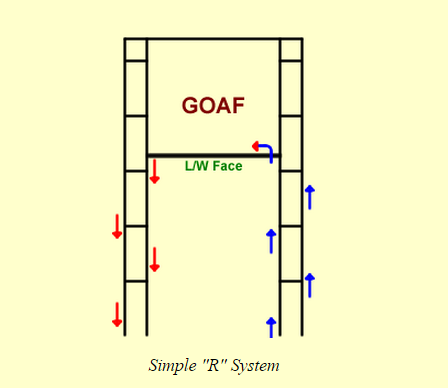
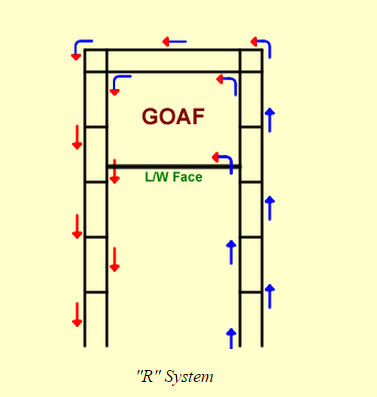
R Ventilation System for Gassy Goafs
This system is suitable for coal seams with moderate gas emmission rates (5 – 10 m3/t). The bleed returns from the goaf are diluted with 20 -30 m3/s of intake air from the panel intakes, depending on gas emission rates. The longwall face is ventilated with 15 – 25 m3/s of air.
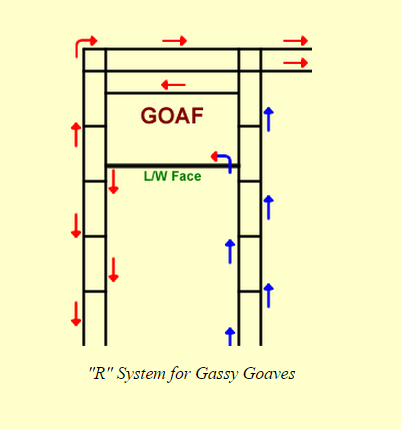
Z VENTILATION SYSTEM
The “Z” system provides the greatest pressure differential accross the goaf and gives the most flexibility for the use of dilution intakes. It is used in coal seams that have a very high gas content ( > 10 m3/t ), this type of ventilation system is used in Appin Colliery which has a gas content of 55 m3/t. Also known as “Y” as the air path is a similar shape to the letter “Y”.
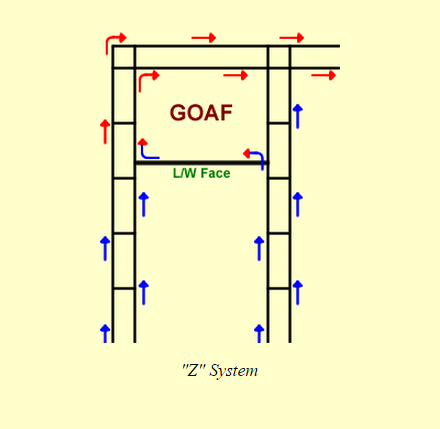
HOMOTROPAL SYSTEM
In particularly dusty mines, the amount of dust in the mine atmosphere can be reduced by directing the air to flow in the same direction that the coal is being transported along the longwall face.
This system is known as homotropal ventilation.
The advantages of this system are:
- The intake air at the face is cleaner
- Reduced dust exposure for workers at the face
- The pantechnicon and the belt conveyor are in seperate gate roads which permits more room in the gate roads. This can also allow narrow the width of gate roads to be driven and reduce the amount of roof support required

ANTITROPAL
The opposite of homotropal ventilation is called antitropal ventilation, in this system the coal is transported along the longwall face in the opposite direction to which the air is travelling.
